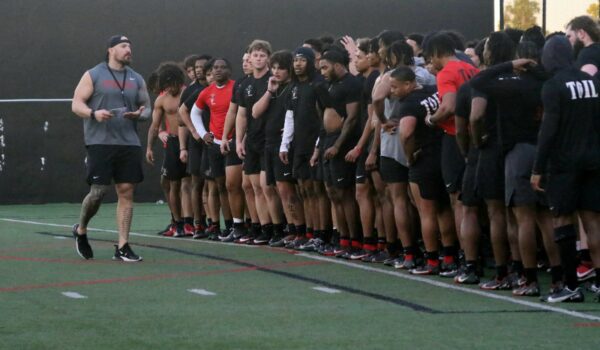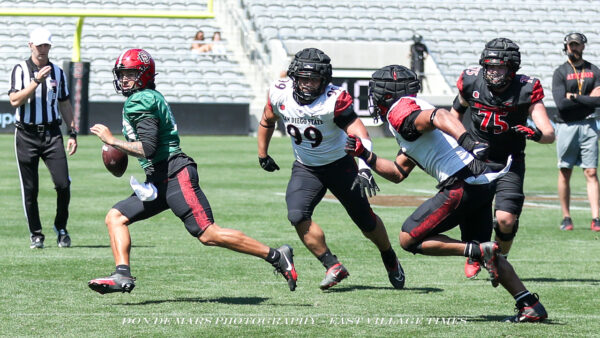College football’s real competition begins May 28 for the Aztecs

Sean Lewis addressing the team during practice. (Don De Mars/EVT)

ESPN’s Bill Connelly released his Post-Spring SP+ rankings on Tuesday.
Connelly’s metric gives a pecking order to every FBS team from No.1 Georgia to No. 134 University of Louisiana Monroe.
SDSU sits at No. 104 in the SP+. Using this ranking as a guide, head coach Sean Lewis’ first season on The Mesa will be disastrous.
Only two FBS opponents on the Aztecs schedule, Central Michigan (119) and New Mexico (131), are below them. SDSU ranks ninth overall in the Mountain West with San Jose State (112), and Nevada (121) joining the Lobos in looking up at the Aztecs. Utah State (101), Hawaii (100), Colorado State (98), Air Force (92), and Wyoming (89) are in the general range as SDSU. UNLV (72), Fresno State (57), and Boise State (38) are significantly higher.
If the SP+ proves accurate, SDSU will be clear favorites in only two games (Texas A&M Commerce and New Mexico) since CMU is on the road. The rankings make them underdogs against BSU, Oregon State (55), Cal (52), Washington State (59), and UNLV. The rest of their contests are toss-ups.
Despite their pretense to the contrary, all metrics and analytics are as subjective as any other approach to ranking teams. They depend on inputs their creators deem significant. Any attempt to order teams is challenging at any point in the year. In the current climate in the sport, doing so in May with any validity is impossible.

Transfer Portal Totals
Everything in college football is designed to favor the Power 4 conferences. The transfer portal is the same. The P4 sends its reserves to the Group of 6 in exchange for the G6’s best athletes. The G6 harvests FCS rosters while sending their backups to the lower level.
According to 247Sports Transfer Portal Tracker, SDSU lost 37 athletes from the 2023 roster and replaced them with 24 players to date. The teams on the Aztecs 2024 schedule lost an average of 18.6 players from a year ago. Even including Air Force, which added zero transfers, the schools SDSU plays next year added a dozen transfers on average to their programs.
Given this reality, it could be argued that returning production is more important than ever, but a compelling case could also be made to the contrary. With so much roster turnover, it is more of an assumption that past results will play out in the future than ever before.
RB Ashton Jeanty, the 2023 MW Offensive Player of the Year, is back for Boise State, but how will losing QB Taylen Green to Arkansas and WR Eric McAlister to TCU impact Jeanty’s production? With more than a third of its scholarship athletes new to the team, how does the chemistry, depth, and change in the practice squad impact the Broncos?
Historically, teams without a slew of new players usually performed better than those breaking in a lot of new talent, but will that maxim still hold when teams’ rosters are made over every couple of years?

The Real Competition is About to Start
“We don’t know” is the unsatisfying answer to all the questions about the impact of NIL and unlimited transfers. Free agency in the professional ranks does not always go according to plan, and its effect on college athletics with younger locker rooms might be even more unpredictable.
Whatever the ultimate value of returning players or adding talent in the transfer portal, the importance of a mostly unseen factor, summer workouts, is elevated as a result of the new dynamics in the sport. The teams that can build chemistry and depth while developing their athletes’ overall skills in June and July will position themselves best for success in the fall.
Summer has always been when players improve most, but team-building matters more now than it did in the past. Reflecting this change, the NCAA changed its rules about coaches overseeing walk-throughs and film study in 2022.
Before the amendment, the strength and conditioning coach could lead up to eight hours a week of mandatory workouts. He could also create workout plans and observe voluntary exercising for safety purposes. Now, coaches can utilize two of those eight hours for walk-throughs or to break down tape.
The idea is for the professionals to train the players on what to do with the athletes mastering them in player-led practices. With a new head coach and 50% of its scholarship players new to the program, the importance of this next phase in the Aztecs’ calendar cannot be overstated.

Phase III
Beginning on Tuesday, May 28, the team will return and get to work. Whether through observation or direct instruction, most of the training will take place under the watchful eye of Jeff Sobol, SDSU’s Head of Football Performance.
Increasing strength was the primary aim of winter conditioning. Summer is all about developing the endurance to play at Lewis’ desired tempo.
If Sobol is unsuccessful in his endeavor, Aztec Fast will be stuck in neutral all year. Should he succeed in developing an extra gear for SDSU’s players to compete with that separates them from the world-class athletes on the opposition, the SP+ ranking will look silly in hindsight.
This summer, Lewis will need to balance Sobol’s efforts with the time his coaches spend fine-tuning the players’ craft. The opportunity cost of more film study or walk-throughs is less Sobol-led work in the weight room.
The QBs, for example, are young by the standards set before unlimited transfers, but in today’s economy, teams depend on underclassmen with increasing frequency. The benefit of more time spent with Lewis or QB coach Matt Johnson this summer is obvious for this year and beyond.
An elite QB is the fastest way to improved play by the Aztecs. Whoever grasps the offense best this summer will likely win the job in August.
If that player goes on to excel in 2024, he will likely have hundreds of thousands, if not millions, of reasons to transfer to another school. That would leave the Aztecs in 2025 where they are now. The better the staff is at immediate development, the more they will need to utilize it each year.
The QB position is one of many where the staff will need to milk every moment of practice time without impacting their strength and conditioning efforts. It is a tall task that will test the quality of Lewis and his staff, but it is the same balancing act that is in front of every team on SDSU’s schedule. The team that thrives now will celebrate when it counts.
The official start of the football season is August 31, but the real competition begins May 28.
May the best team win.
My earliest sport’s memory involve tailgating at the Murph, running down the circular exit ramps, and seeing the Padres, Chargers and Aztecs play. As a second generation Aztec, I am passionate about all things SDSU. Other interests include raising my four children, being a great husband and teaching high school.